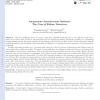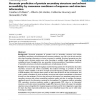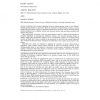805 search results - page 8 / 161 » Solving Consensus Using Structural Failure Models |
115
click to vote
WDAG
2010
Springer
14 years 10 months ago
2010
Springer
Abstract: Due the multiplicity of loci of control, a main issue distributed systems have to cope with lies in the uncertainty on the system state created by the adversaries that ar...
102
Voted
BMCBI
2007
14 years 11 months ago
2007
Background: Structural properties of proteins such as secondary structure and solvent accessibility contribute to three-dimensional structure prediction, not only in the ab initio...
110
Voted
OPODIS
2007
15 years 1 months ago
2007
This paper tackles the consensus problem in asynchronous systems prone to byzantine failures. One way to circumvent the FLP impossibility result consists in adding synchrony assump...
PODC
1990
ACM
15 years 3 months ago
1990
ACM
Emulators that translate algorithms from the shared-memory model to two different message-passing models are presented. Both are achieved by implementing a wait-free, atomic, singl...
EDCC
2005
Springer
15 years 5 months ago
2005
Springer
Unreliable failure detectors are a well known means to enrich asynchronous distributed systems with time-free semantics that allow to solve consensus in the presence of crash failu...




